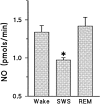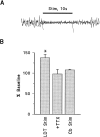Nitric oxide production in rat thalamus changes with behavioral state, local depolarization, and brainstem stimulation
- PMID: 8987767
- PMCID: PMC6793677
- DOI: 10.1523/JNEUROSCI.17-01-00420.1997
Nitric oxide production in rat thalamus changes with behavioral state, local depolarization, and brainstem stimulation
Abstract
Since its discovery as a putative neurotransmitter in the CNS, several functional roles have been suggested for nitric oxide (NO). However, few studies have investigated the role of NO in natural physiology. Because NO synthase (NOS) has been localized in regions believed to be important for attention and arousal, we hypothesized that NO production would be state-dependent. To test this hypothesis, we used in vivo microdialysis, coupled with the hemoglobin-trapping technique, to monitor extracellular NO concentrations in rat thalamus during wake, slow-wave sleep (SWS), and rapid eye movement (REM) sleep. The thalamus is known to receive a massive innervation from the NOS/cholinergic neurons in the mesopontine brainstem, which have been suggested to play a key role in EEG desynchronized states. To test whether thalamic NO output was sensitive to neuronal-dependent changes in the mesopontine brainstem, we measured thalamic NO concentration in response to electrical stimulation in the laterodorsal tegmentum (LDT) of anesthetized rats. Finally, the calcium dependence of NO release was tested by local depolarization with a high potassium dialysate or by addition of a calcium chelator. The results showed that (1) extracellular NO concentrations in the thalamus were high during wake and REM sleep and significantly lower during SWS, (2) thalamic NO release increased in response to LDT stimulation in both a site-specific and tetrodotoxin (TTX)-dependent manner, and (3) NO production was calcium-dependent. These data suggest that thalamic NO production may play a role in arousal.
Figures





Similar articles
-
State-dependent release of acetylcholine in rat thalamus measured by in vivo microdialysis.J Neurosci. 1994 Sep;14(9):5236-42. doi: 10.1523/JNEUROSCI.14-09-05236.1994. J Neurosci. 1994. PMID: 8083733 Free PMC article.
-
Neuronal activities in brain-stem cholinergic nuclei related to tonic activation processes in thalamocortical systems.J Neurosci. 1990 Aug;10(8):2541-59. doi: 10.1523/JNEUROSCI.10-08-02541.1990. J Neurosci. 1990. PMID: 2388079 Free PMC article.
-
Serotonergic inhibition of action potential evoked calcium transients in NOS-containing mesopontine cholinergic neurons.J Neurophysiol. 2000 Sep;84(3):1558-72. doi: 10.1152/jn.2000.84.3.1558. J Neurophysiol. 2000. PMID: 10980027
-
[Selective stimulations and lesions of the rat brain nuclei as the models for research of the human sleep pathology mechanisms].Glas Srp Akad Nauka Med. 2011;(51):85-97. Glas Srp Akad Nauka Med. 2011. PMID: 22165729 Review. Serbian.
-
Counterpointing the functional role of the forebrain and of the brainstem in the control of the sleep-waking system.J Sleep Res. 2004 Sep;13(3):179-208. doi: 10.1111/j.1365-2869.2004.00412.x. J Sleep Res. 2004. PMID: 15339255 Review.
Cited by
-
Sleep and Cellular Stress.Curr Opin Physiol. 2020 Jun;15:104-110. doi: 10.1016/j.cophys.2019.12.011. Epub 2019 Dec 31. Curr Opin Physiol. 2020. PMID: 32043041 Free PMC article.
-
TRANSLATION OF BRAIN ACTIVITY INTO SLEEP.Hirosaki Igaku. 2012;63(Suppl):S1-S16. Hirosaki Igaku. 2012. PMID: 24795496 Free PMC article.
-
Cuneiform neurons activated during cholinergically induced active sleep in the cat.J Neurosci. 2000 May 1;20(9):3319-27. doi: 10.1523/JNEUROSCI.20-09-03319.2000. J Neurosci. 2000. PMID: 10777795 Free PMC article.
-
Sleep loss mediates the effect of stress on nitrergic signaling in female mice.Neurosci Lett. 2021 Jan 1;740:135362. doi: 10.1016/j.neulet.2020.135362. Epub 2020 Nov 6. Neurosci Lett. 2021. PMID: 33166635 Free PMC article.
-
Expression of cGMP-specific phosphodiesterase 9A mRNA in the rat brain.J Neurosci. 2001 Nov 15;21(22):9068-76. doi: 10.1523/JNEUROSCI.21-22-09068.2001. J Neurosci. 2001. PMID: 11698617 Free PMC article.
References
-
- Abarca J, Gysling K, Roth RH, Bustos G. Changes in extracellular levels of glutamate and aspartate in rat substantia nigra induced by dopamine receptor ligands: in vivo microdialysis studies. Neurochem Res. 1995;20:159–169. - PubMed
-
- Adachi T, Inanami O, Sato A. Nitric oxide (NO) is involved in increased cerebral cortical blood flow following stimulation of the nucleus basalis of Meynert in anesthetized rats. Neurosci Lett. 1992;139:201–204. - PubMed
-
- Amir S, Robinson B, Edelstein K. Distribution of NADPH-diaphorase staining and light-induced fos expression in the rat suprachiasmatic nucleus region supports a role for nitric oxide in the circadian system. Neuroscience. 1995;69:545–555. - PubMed
-
- Balcioglu A, Maher TJ. Determination of kainic acid-induced release of nitric oxide using a novel hemoglobin trapping technique with microdialysis. J Neurochem. 1993;61:2311–2313. - PubMed
Publication types
MeSH terms
Substances
LinkOut - more resources
Full Text Sources
